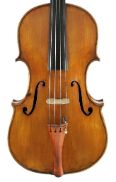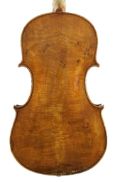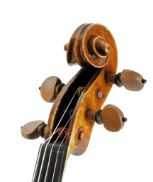Viola, Giovanni Battista Ceruti, Cremona, around 1810
The viola has a non-original label identifying it as the work of Giovanni Battista Guadagnini. Its very short body is built on an individual model with long C-bouts and prominent, long corners. The belly and back have medium-high arching. Ceruti positioned the f-holes very low to increase the f-stop length. The annual rings of the divided belly are of medium width, and both halves of the belly are likely to have been taken from the same log. A knot can be seen on the edge of the bass side. The divided back plate is of irregularly flamed maple and has small knots. Ceruti is likely to have repaired two of these flaws himself with suitable wood when he crafted the viola. The viola’s ribs are made of faintly flamed maple. Its f-holes are slanted because the body is so wide. The broad edges of the belly and back are cleanly executed and transition to broad fluting, above all on the back. The scroll looks delicate by comparison to the large pegbox. The volutes are very regularly formed and deeply undercut. The light and very translucent varnish brings out the lively structure of the wood, especially on the back plate. Thanks to the good overall condition of the instrument, the original varnish is still quite well preserved.





